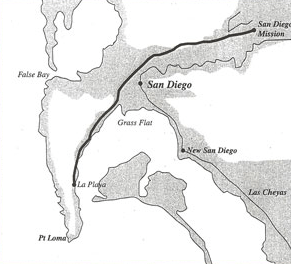La Playa Trail facts for kids

The La Playa Trail was a very old and important path in San Diego, California. It connected the inland areas to a busy port called Old La Playa on San Diego Bay. (La Playa means "the beach" in Spanish.) This trail is known as the oldest commercial path in the Western United States.
People used the La Playa Trail for a very long time. It was used by Native Americans, then by Spanish settlers, and later by Mexican and American people. Today, much of the original trail follows a street called Rosecrans Street in the Point Loma area. Along the trail, there are many historic places. The La Playa Trail Association, started in 2005, helps people learn about this special trail and the many groups who traveled on it.
Contents
The Trail's Long History
The La Playa Trail was already in use before the Spanish arrived in 1769. The first people in the area, like the Kumeyaay tribe, used it to reach the beaches of San Diego Bay. When the Spanish settled the region, they improved and extended the trail. By the 1770s, it reached Old Town San Diego and Mission San Diego de Alcalá in Mission Valley.
Moving Goods and Supplies
Ships would unload their cargo at Ballast Point in Old La Playa. From there, goods were carried several miles inland along the trail to Old Town. The La Playa Trail was the main way to move imports and exports in San Diego. This was true from when San Diego was founded in 1769 until the 1860s. At that time, a better port was built in what is now Downtown San Diego. After most port activities moved, the southern part of the trail became known as Rosecrans Boulevard, which is now Rosecrans Street.
Remembering the Trail
In 1934, six special plaques were placed along the trail. These plaques were made of terra cotta and designed by sculptor Rose M. Hanks. Groups like the Daughters of the American Revolution helped put them up.
Where the Plaques Were Located
The original six plaques were found in different important spots:
- At Mission San Diego de Alcala.
- Near Presidio Hill in Old Town.
- Close to Rosecrans Street and Midway Boulevard in the Midway area.
- At the corner of Rosecrans and Lytton streets in Loma Portal.
- At the corner of Rosecrans and Byron streets in Roseville.
- At the fuel depot site at Naval Base Point Loma.
Plaques Today
By the early 2000s, only four of the original plaques remained. The plaque in the Roseville area had been lost when the street was made wider. A new one was made and put back in 2010. The plaque in the Midway area was moved in 2010 to a spot where more people could see it.
The Trail Now
In 1940, a part of the trail, known as Rosecrans Boulevard, was made into a four-lane highway. From 1964 to 2003, Rosecrans was part of California State Route 209. Today, the very end of the trail is inside Naval Base Point Loma.

